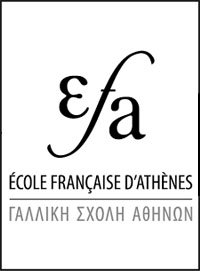Itanos - 2024
Informations Générales
Numéro de la notice
19651
Année de l'opération
2024
Chronologie
Antiquité - Archaïque - Classique - Hellénistique - Romaine
Mots-clés
Nature de l'opération
Institution(s)
Localisation
Toponyme
Itanos
Itanos
Notices et opérations liées
20212024
Description
Crete - Itanos.
(Université libre de Bruxelles) and
(Université libre de Bruxelles) report on the third campaign of the five-year excavation programme at Itanos in east Crete, which focused on four sectors of the necropolis.
The city wall on the south limit of the Necropolis
This year's campaign brought to light an unknown section of the city wall, located in the lower part of the town (Fig. 1). It can now be assumed that the entire urban perimeter was fortified. The section of rampart discovered on the edge of the northern necropolis consists of two wall claddings framing an emplekton. While, due to the scarce material associated with the structure, a precise dating to the original construction was not possible, several repairs have been attributed to the Hellenistic and Roman periods, while a coin of the Emperor Gallien (AD 260-268) provides us with a terminus ante quem for the definitive abandonment of the wall.
The South sector
Located on the western edge of the necropolis, this large-scaled complex structure was in use during the period when there are no known graves in the cemetery (early 6th to the early 4th century BC) (Fig. 2). Following the 2023 campaign, it was possible to validate the south façade’s second occupation phase, (probably 5th century BC). Excavations further revealed that the wall of this south façade extends to the West beyond the west enclosure wall of the Archaic complex.
Inside the Archaic complex, a number of pits with remains of combustion were also uncovered. They were filled in with backfills containing 7th and 6th centuries BC material. Due to the highly degraded state of the archaeological remains, reconstruction of the different phases was not yet possible; only a severe destruction phase was confirmed at the beginning of the 5th century BC, that led to the re-organisation of the whole area as well as the construction of this complex.
«The North terrace»
North to the archaic building, previous excavation campaigns brought to light what used to be referred to as a "terrace". It should now be considered as a very large courtyard (around 400m2), enclosed by a wall. The latter’s layout was defined more precisely this year, both to its north and east sides (Fig. 2). The north side is very much destroyed and shows at least two different building phases. The first one was set on the top of the rock; the second phase probably reused some of the earlier material and was partially set on a lower level. It should further be noted that close to the limits of the northern enclosure wall, the substrate has been removed and worked in several places to create a relatively flat walking surface. Excavations also brought to light the north-east corner of the courtyard. They yielded a few remains of the first (archaic) building phase to the west and to the north. The 2024 excavations are expected to shed light to the rest of this building’s plan. A consolidation base was built against the north-east corner serving as the foundation for an eastern possibly Classical wall. A third building phase of this enclosure wall has also been identified, founded on the levelling of the Classical wall. To the east, outside the yard, the pathway was also found, bordered with graves, probably already looted in Antiquity.
The “intermediary” platform of the necropolis
The pathway that extends to the North led to the upper part of the necropolis. Excavations were carried out in order to better understand the general stratigraphic sequence of the area (Fig. 3). Several funerary periboloi, possibly dating to the Archaic period, were found set on the bedrock. They were destroyed and repaired to be reused during the Hellenistic period. During this latter period, a vast construction program of burials took place in the area. All tombs were dug in the rock, with a small ledge to support a cover of large slabs of soft limestone. Following their looting, an accurate dating of this area of the necropolis is not yet defined. However, evidence suggests a first phase of reoccupation at the end of the 4th century/beginning of the 3rd century BC.
Here, the Hellenistic necropolis probably underwent an episode of destruction during the 2nd century BC. It was discovered that tombs of a new type were built on the destruction of the previous burials. A "platform" made of very loosely bonded large boulders topped with a backfill consisting mainly of rock-cutting waste. These graves, mainly located west of the Archaic and the Hellenistic peribolai, can be dated to the 1st c. BC/1st c. AD. A Roman necropolis was afterwards established on the destruction of the previous burials. The Roman cemetery seems to have been organized around a large central monument (Monument 4). Monument 4 is probably an emblematic tomb from the imperial period, located on a promontory that dominated a large part of the necropolis.
Entry by Katerina Argyraki.
The city wall on the south limit of the Necropolis
This year's campaign brought to light an unknown section of the city wall, located in the lower part of the town (Fig. 1). It can now be assumed that the entire urban perimeter was fortified. The section of rampart discovered on the edge of the northern necropolis consists of two wall claddings framing an emplekton. While, due to the scarce material associated with the structure, a precise dating to the original construction was not possible, several repairs have been attributed to the Hellenistic and Roman periods, while a coin of the Emperor Gallien (AD 260-268) provides us with a terminus ante quem for the definitive abandonment of the wall.
The South sector
Located on the western edge of the necropolis, this large-scaled complex structure was in use during the period when there are no known graves in the cemetery (early 6th to the early 4th century BC) (Fig. 2). Following the 2023 campaign, it was possible to validate the south façade’s second occupation phase, (probably 5th century BC). Excavations further revealed that the wall of this south façade extends to the West beyond the west enclosure wall of the Archaic complex.
Inside the Archaic complex, a number of pits with remains of combustion were also uncovered. They were filled in with backfills containing 7th and 6th centuries BC material. Due to the highly degraded state of the archaeological remains, reconstruction of the different phases was not yet possible; only a severe destruction phase was confirmed at the beginning of the 5th century BC, that led to the re-organisation of the whole area as well as the construction of this complex.
«The North terrace»
North to the archaic building, previous excavation campaigns brought to light what used to be referred to as a "terrace". It should now be considered as a very large courtyard (around 400m2), enclosed by a wall. The latter’s layout was defined more precisely this year, both to its north and east sides (Fig. 2). The north side is very much destroyed and shows at least two different building phases. The first one was set on the top of the rock; the second phase probably reused some of the earlier material and was partially set on a lower level. It should further be noted that close to the limits of the northern enclosure wall, the substrate has been removed and worked in several places to create a relatively flat walking surface. Excavations also brought to light the north-east corner of the courtyard. They yielded a few remains of the first (archaic) building phase to the west and to the north. The 2024 excavations are expected to shed light to the rest of this building’s plan. A consolidation base was built against the north-east corner serving as the foundation for an eastern possibly Classical wall. A third building phase of this enclosure wall has also been identified, founded on the levelling of the Classical wall. To the east, outside the yard, the pathway was also found, bordered with graves, probably already looted in Antiquity.
The “intermediary” platform of the necropolis
The pathway that extends to the North led to the upper part of the necropolis. Excavations were carried out in order to better understand the general stratigraphic sequence of the area (Fig. 3). Several funerary periboloi, possibly dating to the Archaic period, were found set on the bedrock. They were destroyed and repaired to be reused during the Hellenistic period. During this latter period, a vast construction program of burials took place in the area. All tombs were dug in the rock, with a small ledge to support a cover of large slabs of soft limestone. Following their looting, an accurate dating of this area of the necropolis is not yet defined. However, evidence suggests a first phase of reoccupation at the end of the 4th century/beginning of the 3rd century BC.
Here, the Hellenistic necropolis probably underwent an episode of destruction during the 2nd century BC. It was discovered that tombs of a new type were built on the destruction of the previous burials. A "platform" made of very loosely bonded large boulders topped with a backfill consisting mainly of rock-cutting waste. These graves, mainly located west of the Archaic and the Hellenistic peribolai, can be dated to the 1st c. BC/1st c. AD. A Roman necropolis was afterwards established on the destruction of the previous burials. The Roman cemetery seems to have been organized around a large central monument (Monument 4). Monument 4 is probably an emblematic tomb from the imperial period, located on a promontory that dominated a large part of the necropolis.
Entry by Katerina Argyraki.
Auteur de la notice
Georgios Mouratidis
Références bibliographiques
Unpublished field report
Légende graphique :
![]() localisation de la fouille/de l'opération
localisation de la fouille/de l'opération
![]() localisation du toponyme
localisation du toponyme
![]() polygone du toponyme Chronique
polygone du toponyme Chronique
Fonctionnalités de la carte :
![]() sélectionner un autre fond de plan
sélectionner un autre fond de plan
![]() se rapprocher ou s'éloigner de la zone
se rapprocher ou s'éloigner de la zone
![]() afficher la carte en plein écran
afficher la carte en plein écran
Date de création
2024-09-12 19:31:09
Dernière modification
2025-09-02 10:01:07








